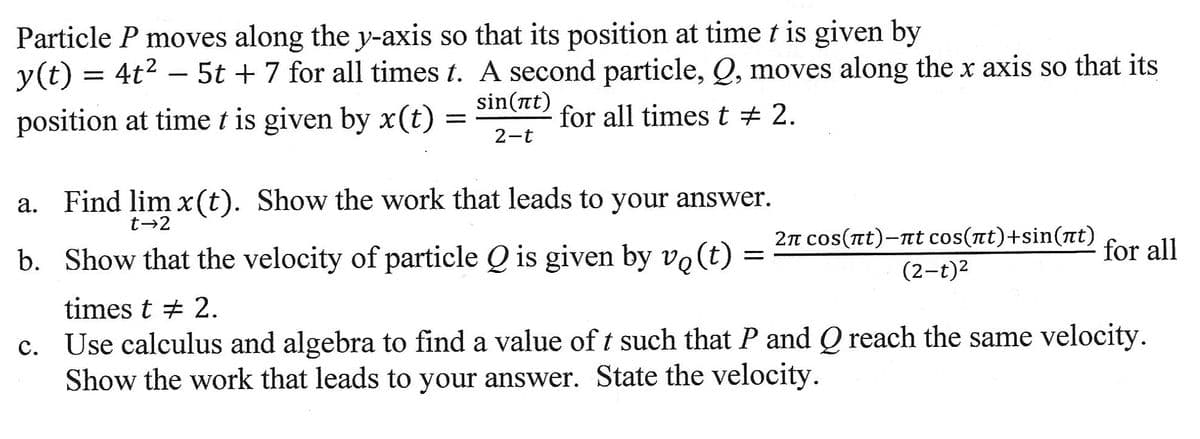Particle P moves along the y-axis so that its position at time t is given by y(t) = 4t² - 5t + 7 for all times t. A second particle, Q, moves along the x axis so that its position at time t is given by x(t): sin(at) 2-t for all times t # 2. = a. Find lim x(t). Show the work that leads to your answer. t-2 b. Show that the velocity of particle Q is given by vo (t) = 2n cos(nt)—rt cos(at)+sin(zt) (2-t)² for all times t = 2. c. Use calculus and algebra to find a value of t such that P and Q reach the same velocity. Show the work that leads to your answer. State the velocity.
Particle P moves along the y-axis so that its position at time t is given by y(t) = 4t² - 5t + 7 for all times t. A second particle, Q, moves along the x axis so that its position at time t is given by x(t): sin(at) 2-t for all times t # 2. = a. Find lim x(t). Show the work that leads to your answer. t-2 b. Show that the velocity of particle Q is given by vo (t) = 2n cos(nt)—rt cos(at)+sin(zt) (2-t)² for all times t = 2. c. Use calculus and algebra to find a value of t such that P and Q reach the same velocity. Show the work that leads to your answer. State the velocity.
College Algebra
7th Edition
ISBN:9781305115545
Author:James Stewart, Lothar Redlin, Saleem Watson
Publisher:James Stewart, Lothar Redlin, Saleem Watson
Chapter3: Polynomial And Rational Functions
Section3.6: Rational Functions
Problem 2E
Related questions
Question
100%
I submitted this same question twice because I am looking for more detail in the solution, especially with part b. Can you help? Thank you.

Transcribed Image Text:Particle P moves along the y-axis so that its position at time t is given by
y(t) = 4t²5t + 7 for all times t. A second particle, Q, moves along the x axis so that its
sin(at)
position at time t is given by x(t)
for all times t # 2.
2-t
=
a. Find lim x(t). Show the work that leads to your answer.
t→2
b. Show that the velocity of particle Q is given by vo(t)
=
2π сos(лt)-лt cos(πt)+sin(πt)
(2-t)²
for all
times t # 2.
c. Use calculus and algebra to find a value of t such that P and Q reach the same velocity.
Show the work that leads to your answer. State the velocity.
Expert Solution
This question has been solved!
Explore an expertly crafted, step-by-step solution for a thorough understanding of key concepts.
This is a popular solution!
Trending now
This is a popular solution!
Step by step
Solved in 2 steps with 2 images

Recommended textbooks for you

College Algebra
Algebra
ISBN:
9781305115545
Author:
James Stewart, Lothar Redlin, Saleem Watson
Publisher:
Cengage Learning

College Algebra
Algebra
ISBN:
9781305115545
Author:
James Stewart, Lothar Redlin, Saleem Watson
Publisher:
Cengage Learning